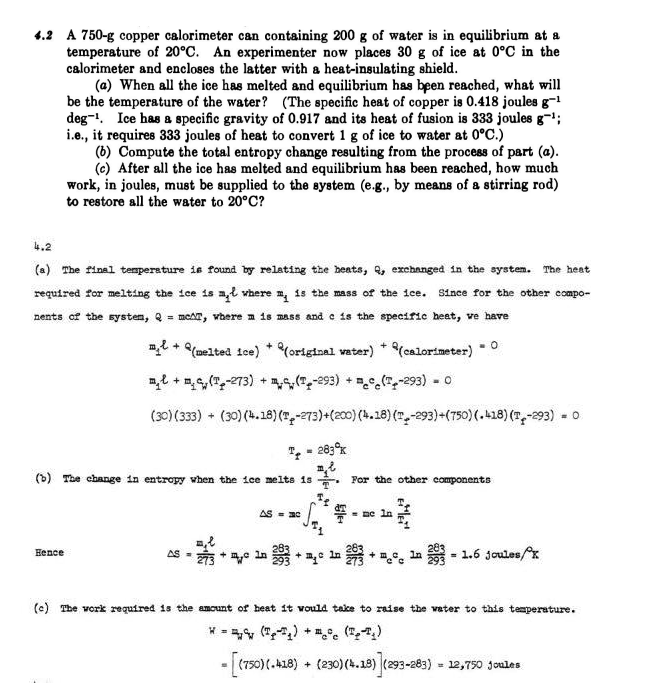A 750-g copper calorimeter can containing 200 g of water is in equilibrium at a temperature of 20°C. An experimenter now places 30 g of ice at 0°C in the calorimeter and encloses the latter with a heat-insulating shield. (a) When all the ice has melted and equilibrium has ben reached, what will be the temperature of the water? (The specific heat of copper is 0.418 joules g-1 deg-. Ice has a specific gravity of 0.917 and its heat of fusion is 333 joules g='; i.e., it requires 333 joules of heat to convert 1 g of ice to water at 0°C.) (6) Compute the total entropy change resulting from the process of part (a). (c) After all the ice has melted and equilibrium has been reached, how much work, in joules, must be supplied to the system (e.g., by means of a stirring rod) to restore all the water to 20°C?
A 750-g copper calorimeter can containing 200 g of water is in equilibrium at a temperature of 20°C. An experimenter now places 30 g of ice at 0°C in the calorimeter and encloses the latter with a heat-insulating shield. (a) When all the ice has melted and equilibrium has ben reached, what will be the temperature of the water? (The specific heat of copper is 0.418 joules g-1 deg-. Ice has a specific gravity of 0.917 and its heat of fusion is 333 joules g='; i.e., it requires 333 joules of heat to convert 1 g of ice to water at 0°C.) (6) Compute the total entropy change resulting from the process of part (a). (c) After all the ice has melted and equilibrium has been reached, how much work, in joules, must be supplied to the system (e.g., by means of a stirring rod) to restore all the water to 20°C?
Related questions
Question
Complete the solution, solve step by step

Transcribed Image Text:4.2 A 750-g copper calorimeter can containing 200 g of water is in equilibrium at a
temperature of 20°C. An experimenter now places 30 g of ice at 0°C in the
calorimeter and encloses the latter with a heat-insulating shield.
(a) When all the ice has melted and equilibrium has been reached, what will
be the temperature of the water? (The specific heat of copper is 0.418 joules g-1
deg-. Ice has a specific gravity of 0.917 and its heat of fusion is 333 joules g-;
i.e., it requires 333 joules of heat to convert 1 g of ice to water at 0°C.)
(6) Compute the total entropy change resulting from the process of part (a).
(c) After all the ice has melted and equilibrium has been reached, how much
work, in joules, must be supplied to the system (e.g., by means of a stirring rod)
to restore all the water to 20°C?
4.2
(a) The final temperature is found by relating the beats, , exchanged in the system. The heat
required for melting the ice is a,ł where n, is the mass of the ice. Since for the other compo-
nents of the systen, Q = meAT, vbere n is mass ande is the specific heat, ve have
l + (melted ice) * (original vater)
(calorimeter)
+ ,,(",-293) + ,°(T-293) - 0
(30) (333) + (30) (4.18)(",-273)+(200) (4.28) (",-293)-(750) (.k18) (,-293) = 0
- 263%
%3D
(b) The change in entropy when the ice melts is
For the other components
AS = 20
= ne in
AS - * e in * ln +. ln- 1.6 joules/*
Hence
(e) The work reguired is the amcunt of heat it vould take to raise the vater to this temperature.
* = y (7,) + . (T)
-(750)(.418) + (230) (4.18) (293-283) = 12,750 joules
%3D
Expert Solution
This question has been solved!
Explore an expertly crafted, step-by-step solution for a thorough understanding of key concepts.
This is a popular solution!
Trending now
This is a popular solution!
Step by step
Solved in 5 steps
